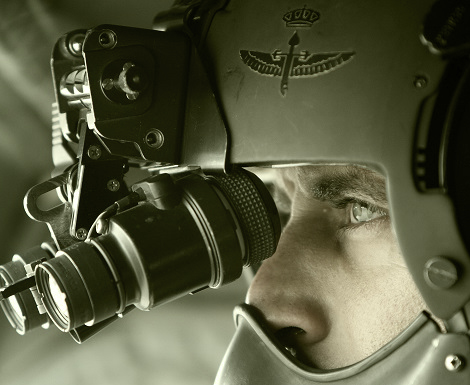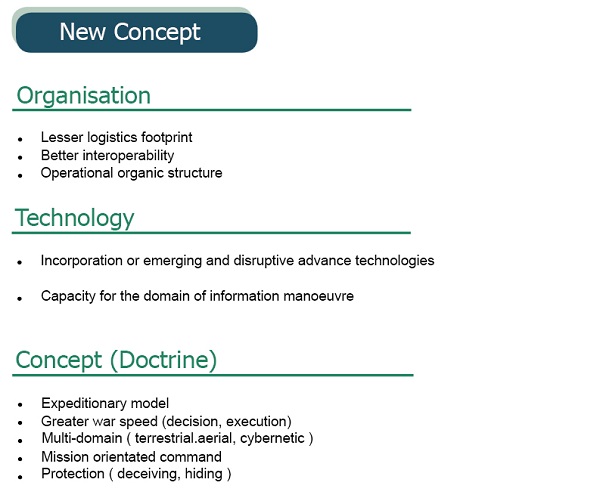- Inicio
- Texto no traducido
- THE ARMY MOVES TOWARDS THE 4.0 ERA
THE ARMY MOVES TOWARDS THE 4.0 ERA
martes 15 de enero de 2019
Número: 73
The 2035 Future Force Centre has already defined the main features and pillars on which the design of the 2035 Brigade will be based. It will enter experimental phase in November, inside the Legion Brigade, at its ‘Álvarez de Sotomayor’ base, located in Viator (Almería).
This project, that will be facilitated thanks to the Army adaptation to the 4.0 technological era, is a necessary step forward as well as an opportunity to be a more efficient and interoperable force. For this reason, emerging and disruptive technologies will be incorporated, such as robotics, artificial intelligence, remote crew air and terrestrial systems, high precision weapons and ammunition....
In operations, the Brigade will deploy at general headquarters with more mobility and less personnel
The new concept of Brigade does not only imply changes in the use of force and organic structures but also, and specially, a change of mentality. One of the key features is the strategic vision of the project that understands the Brigade as an only combat system. This implies the need to be provided with full capacities, that is to say, to have fully prepared brigades for the combat, instead of having them simultaneously provided with medium capacities. Furthermore, the acquisition of smaller groups will contribute to better management and economical saving in the long term, since the speed of technological changes and improvement in materials make them obsolete in the medium term. For this reason, all Army Brigades will be transformed to adopt the new model in a sequential and rotating way, as they acquire integral combat capacities, so that the last in receiving materials and technologies will be the most updated..

The 2035 Brigade is conceived as an expeditionary unit that, with new organisation and culture, advanced technologies and appropriate procedures, sets a faster rhythm both to decision-making and to operations execution. It will deploy a light general headquarters, with better mobility, and less personnel, whose tasks will be mostly performed remotely—either from national territory or reach back. Their action will be performed simultaneously in the terrestrial, aerial and cybernetic fields. On the other hand, the organic structures that they organise will have to be ready—thanks to their cohesion achieved by training in peacetime—to make a quick transition and to be used as operational.
The Army adjusts the step to the new 4.0 technological era, with the main aim of 2035 Brigade
New technologies—apart from increasing combat capacities with less personnel and lesser logistics footprint, and improving interoperability in the great unit—will also permit to control information manoeuvre (with its own communications network that will integrate technological means with a greater number of sensors).
The main technological groups that the new Brigades will foster are the latest RPAS generations (Remotely Piloted Aircraft Systems), land surveillance vehicles, land exploration and reconnaissance vehicles, autonomous land systems, anti-drone systems, artificial intelligence, VCR platforms, 8x8 wheeled combat vehicles and advanced command and control systems, based on satellite systems.

TECHNOLOGY AND PERSONNEL
The social changes that take place up to 2035 will be reflected on the design of the 35 Brigade. Personnel modifications will be compensated by the emerging and disruptive technologies of the moment (new robotics generations, artificial intelligence, nanotechnology.) The final result will be a Brigade with a greater fighting capacity (firepower, mobility, protection.) With human resources variations in its structures, the ‘use of force’ concept will undergo changes, both when performing the traditional kinetic manoeuvre (fire and manoeuvre) and when carrying out information activities (at virtual and cognitive levels) of non-lethal character and sometimes intangible. At nearer horizons such as 2024 and while the Brigade finds itself in process of acquisition of new technologies, the current number of personnel will still remain.
FUERZA 2035 FORUM
Any user with access to the internal network of the Army will be able to take part incorporating comments, information, new approaches or whatever can help in the development and experimentation process, clicking on the Fuerza 2035 Forums link. The email Fuerza_2035@mde.es is also at the disposal of all intranet users, to which messages regarding Fuerza 2035 and the Experimental Brigade can be sent. The Fuerza 2035 site has been created. Accessible from the Fuerza 2035 Forum, all the information related to Fuerza 2035 will be posted there.
LOGISTICS SUPPORT IN THE NEW BRIGADES
At the 2035 horizon, the logistics organisation designed for an operation will be based on the existing logistics support system in the national territory, so they both will have to be compatible and normalised. The variety of settings will put logistics against opposing challenges. Sometimes it will support disperse forces in large areas, with a disperse, discontinuous and changing threat, whereas some other times it will be necessary to fight against an enemy that will be similar to ourselves, with capacity to interfere in the logistics manoeuvre with fire and the deterioration of information and communication systems.
As for the former case, logistics will focus on the knowledge of the situation and demand anticipation, direct sending and resource flow management. As for the latter, logistics in which the existence of levels in the different echelons will be key to face the attacks against our own logistics.
In the operational environment, the capacity to adapt to the unforeseen needs of the combat will be obtained will be reached thanks to command initiative, reach back support and modularity in the organisation. Moreover, the logistics support system will have a command, control and information structure that allows to manage a great volume of data, strongly protected by cybernetic information security systems.
.
SENSORISATION AND ARTIFICIAL INTELLIGENCE
For its part, future logistics support will have to anticipate the needs even more than it does nowadays. This will be achieved thanks to sensorisation, data management based on artificial intelligence, networking, monitoring of resource flow and logistics activities in real time, and to the availability of experts in analysis and interpretation of logistics data.
The flow of information that logistics management will require will be as important as the flow of resources. That is why the automatisation of requests for resources will be the general norm. This will speed up the supply, shorten response time and foster direct and selective delivery.
.
Anticipation of needs will be key to logistics support in the future
Additionally, robotisation and automatisation—with remote terrestrial and aerial systems—will permit the reduction of personnel required for certain operations (vehicle driving, and load preparation and handling, for instance.)
Another issue to be taken into account is the increasing complexity of the new weapon systems. This will require an update in the training of specialists in maintenance, occasional support of personnel in higher echelons through long-distance counselling
(remote maintenance), or the possibility to conduct virtual reparation trial.
For its part, system sensorisation will allow anticipation of needs thanks to the generation of resource consumption and failure prevention data, that will prevent small units from processing the requests as it has been the case until now. On the other hand, it will be necessary to achieve greater reliability of materials, simplification of maintenance tasks, sharing of replacement parts to reduce maintenance time at the vanguard, and effectiveness of material as quickly as possible.
Moreover, in order to reduce the logistics footprint of the small units, and therefore, their vulnerabiity, more emphasis will be placed on energy-efficient technologies, alternative fuels, precision ammunition, or innovation in obtainment of water, among others.
Additive manufacturing will also be fostered in order to obtain certain replacement parts when transportation times are too long, as well as the manufacturing of several components to perform battle damage repair tasks at the vanguard.
Finally, the foreseeable dispersion of the units, together with the difficulties for evacuating and the need to reduce leaves will imply the existence of greater stabilization capacities at the vanguard, which will imply a greater specialisation of the medical personnel and a more demanding health qualification of non-medical personnel.
.
UNIDADES DO EXÉRCITO
- Araba Álava |
- Albacete |
- Alicante |
- Almería |
- Asturias |
- Ávila |
- Badajoz |
- Barcelona |
- Burgos |
- Cáceres |
- Cádiz |
- Cantabria |
- Castellón |
- Ceuta |
- Ciudad Real |
- Córdoba |
- A Coruña |
- Cuenca |
- Girona |
- Granada |
- Guadalajara |
- Gipuzkoa |
- Huelva |
- Huesca |
- Islas Baleares |
- Jaén |
- León |
- Lleida |
- Lugo |
- Madrid |
- Málaga |
- Melilla |
- Murcia |
- Navarra |
- Ourense |
- Palencia |
- Las Palmas |
- Pontevedra |
- La Rioja |
- Salamanca |
- Segovia |
- Sevilla |
- Soria |
- Tarragona |
- Santa Cruz de Tenerife |
- Teruel |
- Toledo |
- Valencia |
- Valladolid |
- Bizkaia |
- Zamora |
- Zaragoza



